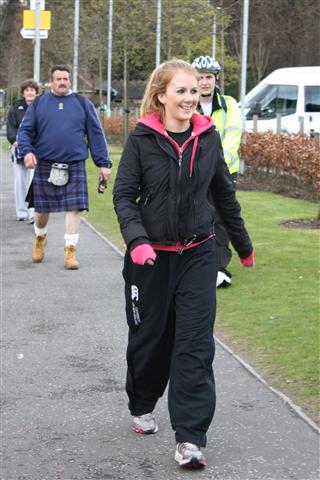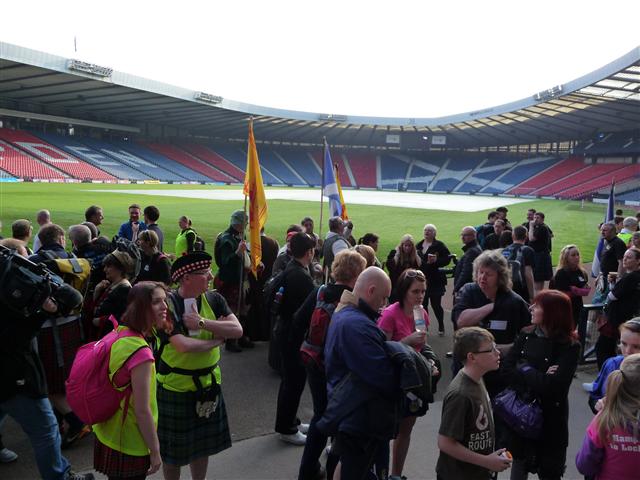|
Get started right away, regardless of your current fitness level.
Even if you already do exercise like playing football, going to the gym or cycling to work, walking uses a different set of muscles and these need to be strengthened for a 26 mile walk. Don’t take it lightly!
Walking up to 26 miles in a row is no ordinary stroll. Preparing for the TACC Kiltwalk will require preparation and training. The more you train the less likely you are to experience pain or injuries on the event. The idea is to work your way up gradually, increasing your activity each week and giving your body time to recover and re-energize between workouts.
The training information contained on this site is meant to be used as a guideline. Before you begin any training plan, you may want to consult with your doctor to go over your current physical condition and determine what you are able to undertake safely.
Training Program
If you are entirely new to exercising, begin with ten-minute walks. Whatever your fitness level, you shouldn't increase your time or mileage by more than 10% to 20% each week. To warm up, start walking at a leisurely pace, gradually picking it up after three to five minutes.
There are many different training plans available online. Most start with a base of approximately 15 - 20 miles a week. These mean walking about 20 miles a week and being capable of walking 4 miles several times a week, with a longer walk once a week.
If you are a beginner walker you should start with less mileage until you have built a good base. The longer you have to build this base the better. It is usually recommended that one have a minimum of six to twelve months walking experience prior to beginning a marathon training program. Your muscles, bones, and joints need sufficient time to adapt to walking prior to the stress of adding mileage, so also stretch before, during and after each walk.
Keep a log of the days you walk and how long you walk, in order to track your progress. Build your mileage up gradually - until the point where you are able to walk 15-18 miles comfortably (with rest stops along the way). Ideally, you should work up to a consistent pace of about three miles per hour or faster. In order to be fully prepared for the event, it is also important to train outside, on a variety of surfaces (pavement, gravel, grass, etc.) using the shoes and equipment that you will use on the event.
Scheduling Your Training
After you've created your ideal training schedule, your next thought might be, "where am I going to find the time to do all this?" You can build endurance by fitting in small walks throughout your day. Get up a little earlier in the morning and fit in a training walk before work. Walk to work. Walk on your lunch hour. On the weekends, "walk" your errands instead of driving around.
If the weather is a concern, remember that you can get going on training walks indoors or in a gym. Alternatively, you may choose to brave the elements (within reason) with weatherproof clothing and plenty of layers to keep you warm and dry.
In your enthusiasm over training, be sure to take one day off per week to rest, in order to avoid injury. When you're walking with others, don't push yourself beyond your ability. Listen to your body - and keep yourself healthy.
You may also consider including a taper period. This is a time prior to the walk when mileage decreases allowing your body to rest and rebuild. Your training schedule could have the last and longest walk three weeks prior to the Kiltwalk and decrease mileage each week until Kiltwalk day.
Stretching
Stretch before, during and after your walk to avoid injury. Stretch for five minutes of every hour that you are walking - it can mean the difference between enjoying the event and just getting through it.
Hydration
Hydrate with both water and sports drinks during all training activities. Don't wait until you feel thirsty. As a general rule, drink a bottle of water and a bottle of sports drink every two to three miles when walking or every hour of cardiovascular activity. On the day we will have bottled water at each scheduled check point.
Nutrition
When you are doing any type of long distance activity, your body needs adequate fuel (food) in order to perform at an optimum level. It is important to refuel your body with foods that contain quality calories that will give you the energy needed to safely and successfully complete training walks as well as the event itself.
If your body runs out of fuel, you may begin to have symptoms of low blood sugar such as disorientation, headache, weakness or loss of body control. If you begin to notice any of these symptoms while training, it is important to stop exercising, sit down, and start eating and drinking immediately. If symptoms persist, see your doctor.
Foot and Blister Care
Blisters are the most common foot problem seen during long-distance walking events. Blisters are your body's way of creating a natural protective cushion to protect your feet.
- Most occur on the ball or heel of the foot, or underneath the big toenail.
- Friction rubs are the direct cause of blisters. Any amount of friction between skin and skin, skin and sock, sock and shoe, etc., eventually will cause a blister.
- Anywhere on the feet or toes where you feel pressure, tenderness, pain, heat, or burning is an area of potential blister.
- When you remove your shoes and socks after walking, check your feet for hot spots. Areas that are more tender, red, or warm are most likely to form a blister during subsequent walks.
- The following guidelines should be followed during training and the walk to help you take care of blisters should they occur:
- If you develop a blister during training, do not pop or peel it; let nature take its course and heal the blister before you hit the pavement again. A few days of rest will be more beneficial to your training than trying to walk through the pain.
- If you develop a blister during the event, cleanse the area with rubbing alcohol and drain the blister, ONLY IF NECESSARY, allowing the fluid to drain completely.
- Cover the blister, opened or not, with antibiotic ointment and gauze or a bandaid. Provide protective cushioning with some type of padding (moleskin, Second Skin, etc.).
- If the blister is under a toenail, drain it and tape the toenail in place. If the nail is loose and looks like it might cause a problem, see a podiatrist (foot doctor) for further evaluation.
Be prepared to do your own minor blister care when training as well as at the event. Always carry a blister kit in your waist pack while on the route. It should contain the following items:
- Bandaids.
- Alcohol pads.
- Moleskin dressing material.
- Blister pads (available at any drugstore).
- Small scissors (to cut dressing material).
- Minor over-the-counter pain relief medications.
- Tubefoam (Available at any drugstore).
- Medical tape
- Gauze pads (sterile, individually wrapped).
If you need further care during the event, please see a medical crew member at a check point.
You'll want to purchase shoes, socks and clothing far enough in advance of the Kiltwalk that you can break everything in. Do not wear new shoes on the event. It will only result in blisters and possibly other injuries.
Walking Clothes and Equipment
Walking is an easy, simple exercise and doesn't require much in terms of equipment or special clothing. You will benefit, however, from investing in a few key pieces to help keep you comfortable and injury-free on your walks.
Shoes
Start at the bottom - nothing is as important as a good pair of well-fitted shoes. Visit a store with knowledgeable employees that can help you to find the right shoe. A few tips for shoe shopping:
- Shop for shoes in the late afternoon, as your feet will tend to swell during the day.
- Either a walking shoe or a running shoe will work this event. You might want to try one of each to see which you prefer.
- There are four key factors to consider when choosing shoes: Fit, Comfort, Cushion and Control.
- There should be 1/2 to 3/4 inch between the tip of your longest toe and the end of the shoe while standing. Make sure you have ample room for your toes to spread.
- Athletic shoes should be comfortable from the start, requiring minimal break in.
- Try on both shoes. If one foot is larger than the other, fit the larger foot.
- Make sure the heel fit is snug, and does not slip up and down when you walk.
- Remember to replace your walking and running shoes every 300 to 500 miles (4 to 6 months for regular walkers/runners).
Socks
Your choice of socks is another important decision and can make a big difference in your walking comfort. Nothing can ruin a walk faster than blisters, which are caused by moist feet and friction. It's important to find a sock that keeps your feet dry and comfortable and provides cushion and support.
A few tips for sock shopping:
- Do NOT buy 100% cotton socks. Cotton absorbs moisture instead of wicking it away, making your feet soggy and uncomfortable and increasing your chances of developing blisters.
- Instead, get socks that are made from either synthetic fibres (acrylic, CoolMax, nylon, Polartec) or a blend of natural fibers (cotton, wool) and synthetic fibres. These socks are designed to wick away the moisture and keep your feet dry.
- Try different pairs of socks to see which ones are best for your feet. Socks offer different kinds of thickness and padding - those that are padded in the heel and toe areas are good choices for long-distance walkers.
- Make sure your socks are compatible with your shoes - they shouldn't twist or bunch up.
Other Clothing
Your walking clothes are a personal choice and different options work for different people - but make sure that whatever you wear won't ride up, isn't too restrictive and doesn't cause chafing. You should be comfortable and prepared for the weather. Layering clothing is often a good idea during a long walk, as both you and the day may warm up as you move along.
Other Gear
There's one other walking essential, and that's a water bottle (or bottles) or hydration system. Even on short walks, get in the habit of hydrating often - you'll be glad once you start walking further.
What you choose to wear is up to you; what's most important is that you do your experimenting while you're training. By the time you arrive at the Kiltwalk, you should be certain that your shoes, socks, and gear are "broken in" and completely comfortable.
|







